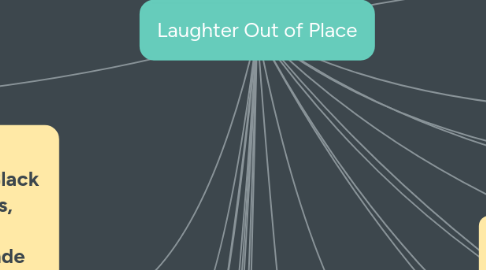
1. Police corruption
1.1. Police brutality and violence
1.2. Police works with gang members
1.2.1. Police profit from working with Gangs
2. Upper class treat the working class differently
2.1. The upper class abuse and exploit the working class
2.1.1. Love/ Hate Relationships
3. Chapter 2:The Aesthetics of Domination
3.1. Class, Culture, and The Lives of Domestic Workers
3.1.1. Letter from Dona Beth's daugther
3.1.1.1. Dona Beth would like to keep her daughter close to her, however, her daughter wants to be more independent
3.1.1.1.1. Gloria wants to see her kids become more independent
3.1.1.2. Gloria and Sonceca laugh at the letter Dona Beth received from her daughter.
4. The struggle to survive while getting paid minimum wage
4.1. A lot of time away from family to be able to earn a living
4.1.1. Working class earns only $6 a day
4.1.1.1. Gloria earns 5 minimum wage payments
4.2. Long periods of work hours
4.2.1. A lot of Poverty in Brazil
4.2.1.1. The economy is bad in Brazil
5. Chapter 3:Color-Blind Erotic Democracies, Black Consciousness Politics, and the Black Cinderellas of Felicidade Eterna
5.1. Discrimination between the races black/white is still very real in Brazil
5.2. White people are conisred superior than black people
5.2.1. White people are wealthier and have more political stance
6. Cinderellas of Felicidad Eterna
6.1. The governor's daughter was assaulted for making a white middle class women wait
6.1.1. Many forms of racial segregation
6.2. This incident brought light to the racial injustices in Brazil
7. The Treasure Chest Coup
7.1. Brazilian women fantasize about seducing men with money
7.1.1. Seen as an opportunity for Brazilian women to have a "better" and more comfortable lifestyle
7.1.1.1. Usually seen has a way out of poverty
7.1.1.2. Empowering for Brazilian women
7.2. The women are beautiful and young, while the man are older and with money
8. Chapter 4: No Time for Childhood
8.1. Young children of poor families are out in the streets working trying to survive financially
8.1.1. Children are forced to grow up fast because of their financial situation
8.2. Children of the age 8 and younger are forced to work to be able to eat.
8.2.1. Street violence is a common thing
9. Funabem and Febem
9.1. Institution for orphans and poor kids
9.1.1. Children are victims of physical, emotional, and sexual abuse
9.1.1.1. Children go through a lot of hardships and struggles
9.2. Institution is dirty and not kept clean
9.2.1. Institution is overcrowded
10. A visit with Pedro Paulo at Ilha Grande Prison
10.1. Also known as the Devil's Cauldron
10.1.1. Gloria and Goldstein visit Pedro in prison
10.2. Pedro is serving a 15 year sentence for armed robbery
10.2.1. Gloria considered him to be one of her smartetst children
11. Chapter 5: State Terror, Gangs, and Everyday Violence in Rio de Janeiro
11.1. Violence and Crime is everywhere
11.2. Gangs rule the streets in Rio de Janeiro
11.3. Young men see gangs as an opportunity to grow and be "successful"
11.3.1. Power trip for young men
11.3.1.1. Seen as a way to escape poverty
12. Fear and terror rule the streets in Rio de Janeiro
12.1. Drug substance abuse is common
12.2. Gangs are in charge of distributing drugs
12.2.1. Violence against women and different races
13. Gloria laughing after hearing about Zeca's death
14. Different socioeconomic groups
15. Poverty and wealth
16. Carnivals are an important part of the culture
17. Introduction: "Hard Laughter". Goldstein begins the book with a powerful quote by Mark Twain, and it states, "The secret source of humor is not joy but sorrow. There is no humor in heaven." I believe this quote sets the tone for the rest of the book. Goldstein challenges the reader to dig deep and see the harsh reality of what is like to live in Brazil in the Favela. I realized that one of the major underlying themes of this book is incorporating humor to hard situations that are in fact, not humorous at all. Humor is often used as a coping mechanism.
18. Chapter.1 Laughter "Out of Place". The beginning of the book is about Goldstein's return to Brazil. She moves in with Gloria (they have been friends for a long time) and her family to study about their culture and their way of life. Goldstein see's Gloria's struggles and everyday hardships. It is surprising to Goldstein to see how Gloria can still manage to laugh after going through so much pain. Once again, bringing back the theme of humor into the story. Goldstein writes about poverty and ethnography. And at the end of the chapter she gives a brief history of Brazil.
19. Dark Humor to cope with pain
20. Gender roles
21. Oppressed Women
22. Poverty
23. The story takes place in Shanty Towns of Brazil
24. Chapter 6 and 7
24.1. Sexuality
24.1.1. Women sexually tease men
24.1.1.1. Women sexuality is used to get higher on society
24.2. Machismo is part of the brazialian culture
24.2.1. Men rule the world
24.3. Women dont have a voice
24.4. Women are objectify by men
24.5. Men take advantage of women
24.5.1. Gloria believe men are animals
24.6. Children are abused by men
24.7. Rape happens a lot in brazil
24.7.1. Two men raped Anita and Claudia in Gloria's house
24.8. Men are more finiancially well of than women
24.8.1. Women use men for their financial success
24.8.1.1. To get higher up in the social ladder

